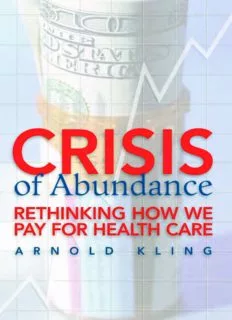
Crisis of Abundance: Rethinking How We Pay for Health Care PDF
Preview Crisis of Abundance: Rethinking How We Pay for Health Care
CRISIS of Abundance RETHINKING HOW WE PAY FOR HEALTH CARE CRISIS of Abundance RETHINKING HOW WE PAY FOR HEALTH CARE A R N O L D K L I N G WASHINGTON, D.C. Copyright©2006bytheCatoInstitute. Allrightsreserved. LibraryofCongressCataloging-in-PublicationData Kling,ArnoldS. Crisisofabundance:rethinkinghowwepayforhealthcare/ArnoldKling. p.cm. Includesbibliographicalreferences. ISBN1-930865-89-9(alk.paper) 1. Medical care, cost of—United States. 2. Healthcarereform—United States. 3.Medicaleconomics—UnitedStates. I.Title. RA410.53.K5862006 338.4’33621—dc22 2006043904 CoverdesignbyJonMeyers. PrintedintheUnitedStatesofAmerica. CATOINSTITUTE 1000MassachusettsAve.,N.W. Washington,D.C.20001 www.cato.org Contents ACKNOWLEDGMENTS vii PREFACE ix INTRODUCTION 1 1. The Rise of Premium Medicine 7 2. Three Health Care Narratives 19 3. Dollars and Decisions 33 4. No Perfect Health Care System 45 5. Insulation vs. Insurance 51 6. Matching Funding Systems to Needs 63 7. Markets and Evolution 77 8. Policy Ideas 85 CONCLUSION 95 NOTES 97 INDEX 105 ABOUTTHEAUTHOR v Acknowledgments BrinkLindseyapproachedmewiththeideaofwritingabookon health care financing policy, and he then gave me a free hand in creatingit. MichaelCannon wasextremely generouswith histime, sendingmetopicalarticles,thoroughlyreadingthemanuscriptsev- eral times, and making a number of suggestions that greatly improvedthefinalproduct.Otherswhoprovidedhelpfulcomments includedIainMurray,RobinHanson,TylerCowen,AlexTabarrok, and Peter Van Doren. Adrienne Aldredge and others at Cato also provided important support. I would like to express my appreciation to the technical team at theAgencyforHealthResearchandQualityformakingtheMedical Expenditure Panel Survey information accessible via the World Wide Web in such a user-friendly manner. This is an instance in which a Cato author feels compelled to acknowledge the existence of a public good. Notwithstanding all of the valuable assistance I received, any errors of fact or analysis are solely my own. vii Preface Healthcarecostsaffectusasconsumers,asworkers,assharehold- ers, and as taxpaying citizens. Why are health care costs rising so rapidly?Whatarethetradeoffsinvolvedinchoosingdifferentways to pay for health care? How can we improve efficiency and equity in the health care system? The goalof this bookis to presenta reasonable setof answers to those questions, and to provide factual and analytical background for policy discussions concerning how we pay for health care and howthataffectstheavailabilityandqualityofhealthcare.Thegoal isnottopressaspecificsetofsolutionsorproposals,buttoarticulate an economic perspective on the issues involved. An economic per- spective is important because much of the uneasiness about health care in the United States today relates to cost. The questions posed are ones that an economist can attempt to investigate. In preparing this book, I reviewed some of the voluminous aca- demicand policyliterature,andI triedtoassembledata thatcould help shed light on important issues. In some cases, I found the statistics that I was looking for in the literature. In a few cases, I was able to work with source data to develop answers. In other cases, it seems that we have to do without definitive data for now. The audience for this book is the concerned citizen. The analysis isintendedtobecredibletoprofessionaleconomistswhilereadable fornoneconomists.Ihopethateveryonewhoreadsthisbook,econo- mist and noneconomist alike, will be able to take away useful insights. ix
